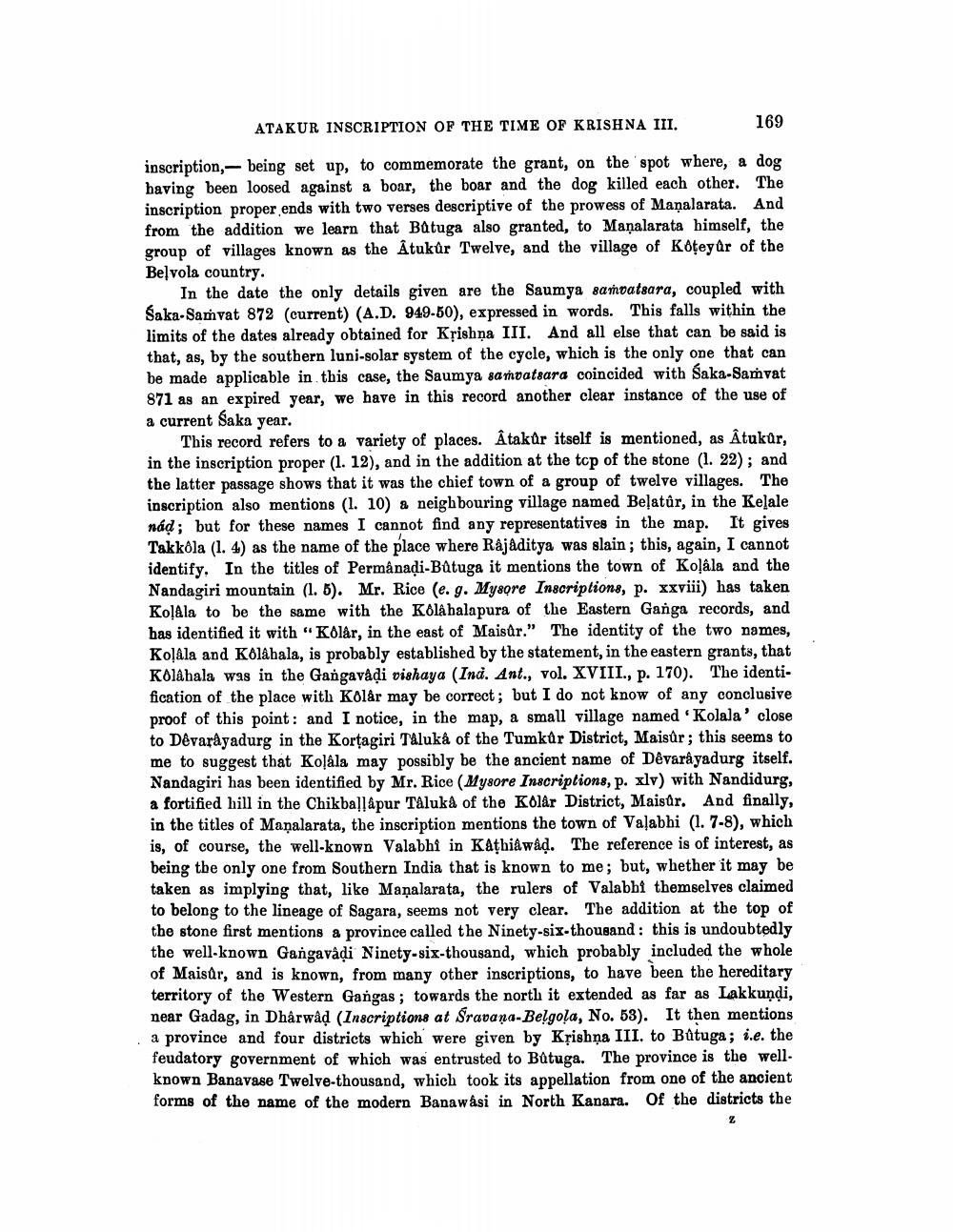________________
ATAKUR INSCRIPTION OF THE TIME OF KRISHNA III.
169
inscription, being set up, to commemorate the grant, on the spot where, a dog having been loosed against a boar, the boar and the dog killed each other. The inscription proper ends with two verses descriptive of the prowess of Manalarata. And from the addition we learn that Batuga also granted, to Maṇalarata himself, the group of villages known as the Atukûr Twelve, and the village of Kôteyûr of the Belvols country.
In the date the only details given are the Saumya samvatsara, coupled with Saka-Samvat 872 (current) (A.D. 949-50), expressed in words. This falls within the limits of the dates already obtained for Krishna III. And all else that can be said is that, as, by the southern luni-solar system of the cycle, which is the only one that can be made applicable in this case, the Saumya samvatsara coincided with Saka-Samvat 871 as an expired year, we have in this record another clear instance of the use of a current Śaka year.
This record refers to a variety of places. Atakûr itself is mentioned, as Âtukûr, in the inscription proper (1. 12), and in the addition at the top of the stone (1. 22); and the latter passage shows that it was the chief town of a group of twelve villages. The inscription also mentions (1. 10) a neighbouring village named Belatúr, in the Kelale nád; but for these names I cannot find any representatives in the map. It gives Takkôla (1. 4) as the name of the place where Râjâditya was slain; this, again, I cannot identify. In the titles of Permânadi-Batuga it mentions the town of Kolâla and the Nandagiri mountain (1. 5). Mr. Rice (e. g. Mysore Inscriptione, p. xxviii) has taken Kolala to be the same with the Kôlâhalapura of the Eastern Ganga records, and has identified it with "Kôlår, in the east of Maisûr." The identity of the two names, Kolala and Kôlâhala, is probably established by the statement, in the eastern grants, that Kolâhala was in the Gangavâḍi vishaya (Ind. Ant., vol. XVIII., p. 170). The identification of the place with Kôlår may be correct; but I do not know of any conclusive proof of this point: and I notice, in the map, a small village named 'Kolala' close to Devarayadurg in the Kortagiri Taluka of the Tumkûr District, Maisûr; this seems to me to suggest that Kolâla may possibly be the ancient name of Dêvarâyadurg itself. Nandagiri has been identified by Mr. Rice (Mysore Inscriptions, p. xlv) with Nandidurg, a fortified hill in the Chikballapur Taluka of the Kolar District, Maisûr. And finally, in the titles of Manalarata, the inscription mentions the town of Valabhi (1. 7-8), which is, of course, the well-known Valabhi in Kathiawaḍ. The reference is of interest, as being the only one from Southern India that is known to me; but, whether it may be taken as implying that, like Manalarata, the rulers of Valabhi themselves claimed to belong to the lineage of Sagara, seems not very clear. The addition at the top of the stone first mentions a province called the Ninety-six-thousand: this is undoubtedly the well-known Gangavadi Ninety-six-thousand, which probably included the whole of Maisûr, and is known, from many other inscriptions, to have been the hereditary territory of the Western Gangas; towards the north it extended as far as Lakkundi, near Gadag, in Dharwad (Inscriptions at Sravana-Belgola, No. 53). It then mentions a province and four districts which were given by Krishna III. to Bûtuga; i.e. the feudatory government of which was entrusted to Bútuga. The province is the wellknown Banavase Twelve-thousand, which took its appellation from one of the ancient forms of the name of the modern Banawâsi in North Kanara. Of the districts the
Z




